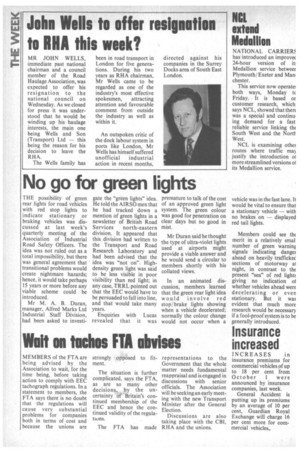No go for green lights
Page 20

If you've noticed an error in this article please click here to report it so we can fix it.
THE possibility of green rear lights for road vehicles with red stop lights to indicate stationary or braking vehicles was discussed at last week's quarterly meeting of the Association of Industrial Road Safety Officers. The idea was not ruled out as a total impossibility, but there was general agreement that ' transitional problems would create nightmare hazards; hence, it would take perhaps 15 years or more before any viable scheme could be introduced.
Mr M. A. B. Duran, manager, Alfred Marks Ltd Industrial Staff Division, had been asked to investi gate the "green lights" idea. He told the AIRSO men that he had tracked down a mention of green lights in a newsletter of British Road Services north-eastern division. It appeared that this division had written to the Transport and Road Research Laboratory and had been advised that the idea was "not on". Highdensity green light was said to be less visible in poor visibility than red light; in any case, TRRL pointed out that the EEC would have to be persuaded to fall into line, and that would take many years.
Enquiries with Lucas revealed that it was premature to talk of the cost of an approved green light system. The green colour was good for penetration on clear days but no good in mist.
Mr Duran said he thought .the type of ultra-violet lights used at airports might provide a viable answer and he would send a circular to members shortly with his collated views.
In an animated discussion, members learned that the green rear light idea would involve red stop/brake lights showing when a vehicle decelerated; normally the colour change would not occur when a vehicle was in the fast lane. If would be vital to ensure that a stationary vehicle — with no brakes on — displayed red tail lights.
Members could see the merit in a relatively smal number of green warnini signals indicating dangei ahead on heavily traffickec sections of motorway at night, in contrast to the present "sea" of red lights giving no indication of whether vehicles ahead were decelerating or even stationary. But it was evident that much more research would be necessary if a fool-proof system is to be generally introduced.




























































































































































